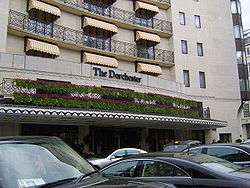William Curtis Green
| William Curtis Green | |
|---|---|
|
The Queens Hotel in Leeds | |
| Born |
16 July 1875 Alton, Hampshire |
| Died |
26 March 1960 (aged 84) His house in Pall Mall, London |
| Nationality | English |
| Occupation | Architect |
| Awards | Royal Gold Medal (1942) |
| Buildings | Dorchester Hotel |
William Curtis Green RA (16 July 1875 – 26 March 1960) was an English architect.
Green was born in Alton, Hampshire. He studied engineering at the technical school at West Bromwich and architecture at Birmingham School of Art. Articled to John Belcher from 1895 he studied part-time at the Royal Academy. In 1897 he joined the staff at The Builder as the draughtsman. He joined the Art Workers Guild.
He founded his architectural practice in 1898, also marrying that year Cicely Dillworth Lloyd. His first commissions included several power stations. In 1910 he formed a partnership with Dunn and Watson.
In 1942 Green was awarded the Royal Gold Medal of the Royal Institute of British Architects.
Architectural works

The Dorchester Hotel, London (1930)
Green's works include:[1]
- Bristol Tramways Power Station (1899)
- Brislington Tram Depot (1900)
- Hove Power Station (1900)
- Chiswick Power Station (1904)
- The Tuckett's Farm Estate, Netherton, Devon (1904)[2]
- Dolobran Chislehurst (1905)
- Quaker Meeting House, Croydon (1905)
- Church of the Good Shepherd, Dockenfield, Surrey (1910)[3]
- Scottish Provident Building, Lombard Street, London (1912)
- Scottish Provident Building, Pall Mall, London (1912)
- Rystwood House, Forest Row, Sussex (1913)
- Hardwick Garden City Housing Estate, Chepstow (1915)
- Wolseley Motor Showrooms, 160 Piccadilly, London (later Barclay's Bank; now The Wolseley café restaurant) (1922)
- Workshops at Oxford for Wolseley Motors (1923)
- Old Stanmore Estate Winchester (1924)
- Ashmore Manor, Dorset (1925)
- Westminster Bank 63 Piccadilly (1926)
- London Life Assurance Building King William Street (London) (1927)
- 9 Duke Street St James's (1928)
- Stockgrove Park (1929)
- Stratton House Piccadilly (1929)
- The Dorchester Hotel, London (1930–31) with Owen Williams
- St. George's Church (1932)
- Barclay's Bank, Knightsbridge (1932)
- Goodmans Furze, Headley, Surrey (1932)
- Scottish Widows Fund Building, Cornhill, London (1932)
- St Christopher's Church, Cove, Hampshire (1934)
- Barclay's Bank, Bond Street (1935)
- Houses and Cottages, Tamerton Foliot (1936)
- Equity Law Building, Lincoln's Inn Fields (1936)
- Extension, Scotland Yard, Victoria Embankment (The Curtis Green Building)[4](1937–40)
- Robinswood House, Fairwarp, Sussex (1937)
- Bentley House, NW1 (1937)
- Cambridge University Press (1938)
References
- ↑ page 51 W. Curtis Green R.A. Architect and Draughtsman 1875-1960, Heinz Gallery, 1978
- ↑ Smiles, Sam (1998). Going modern and being British : art, architecture and design in Devon c. 1910-1960. Exeter, England: Intellect. p. 36. ISBN 9781871516951.
- ↑
- Nairn, Ian; Pevsner, Nikolaus (1971) [1962]. The Buildings of England: Surrey (2nd ed.). Harmondsworth: Penguin Books. p. 194. ISBN 0-300-09675-5.
- ↑ Foreman, Susan (1995). From palace to power : an illustrated history of Whitehall. Brighton: Alpha Press, in association with Sussex Academic Press. p. 151. ISBN 9781898595106.
- Edwardian Architecture: A Biographical Dictionary, A. Stuart Gray 2nd Edition 1988. Pages 199-200.
- Directory of British Architects 1834-1914 Volume 1: A-K, Antonia Brodie, Alison Felstead, Jonathan Franklin, Leslie Pinfield and Jane Oldfield, 2001 Continuum. Pages 777-779.
- W. Curtis Green, Representative British Architects of the Present Day, C.H. Reilly, 1931 B.T. Batsford Ltd. Chapter VIII.
- W. Curtis Green R.A. Architect and Draughtsman 1875-1960, Heinz Gallery, 1978
External links
This article is issued from
Wikipedia.
The text is licensed under Creative Commons - Attribution - Sharealike.
Additional terms may apply for the media files.